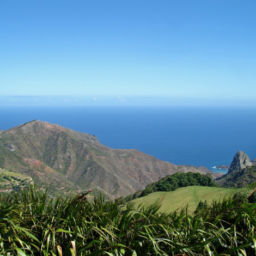by Mark Stevenson
Where in the world is Saint Helena? So apt a question was this that it became a marketing slogan for the tiny island in the South Atlantic off the southwest coast of Africa. Unless you listened in history class, are a Napoleon buff or were schooled in France, Google may be your best bet.
Head to 15°56′S 5°43′W and zoom in. Saint Helena is a British Overseas Territory, situated in the South Atlantic high-pressure zone. Only 6 by 8 miles, the volcanic rock rises from sea level to 2,625 feet, and features desert plains, sub-tropical forests and over 400 endemic species. An international airport is slated to begin operations in 2016, but for now the only way to get here is aboard the RMS St. Helena, which sails from Cape Town. It’s remoteness, combined with near year-round warm weather and ocean temperatures ranging from 64 to 79 degrees Fahrenheit, makes St. Helena a true hidden gem for divers.
We are spoiled for local dive sites; a favorite is the wreck of the SS Papanui. A steamer that caught fire in the bay in 1911, it burned out but remained afloat. Years later the local authorities scuttled it and today the steering gear can still be seen protruding from the swell. Resting in only 46 feet at the deepest point and running roughly east west across James Bay, the stern remains largely intact and is home to shoals of butterflyfish, sergeant majors and endemic St. Helena pufferfish. Swim inshore and the mid-deck crumbles into the ocean floor with the shape of the ship still visible via the structural beams. On a still day the visibility regularly exceeds 82 feet and a short swim brings the three boilers into view. They rest atop the collapsed structure, providing a home to South Atlantic lobsters, crayfish and moray eels and countless other species.
The bow marks the dive’s halfway point; turn north and follow the rock outcroppings, moorings and stone walls back to the landing steps. On a lucky day a hawksbill turtle might pop in to check out some of the most remote divers in the world.


